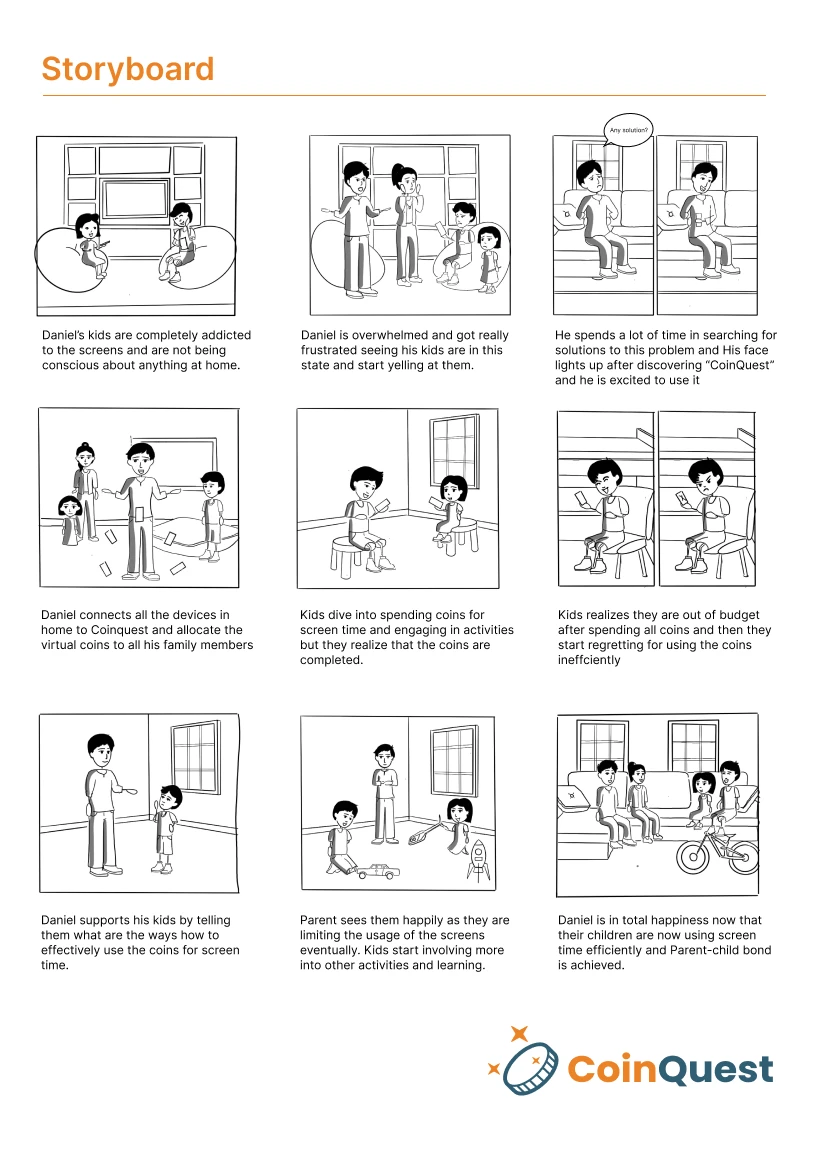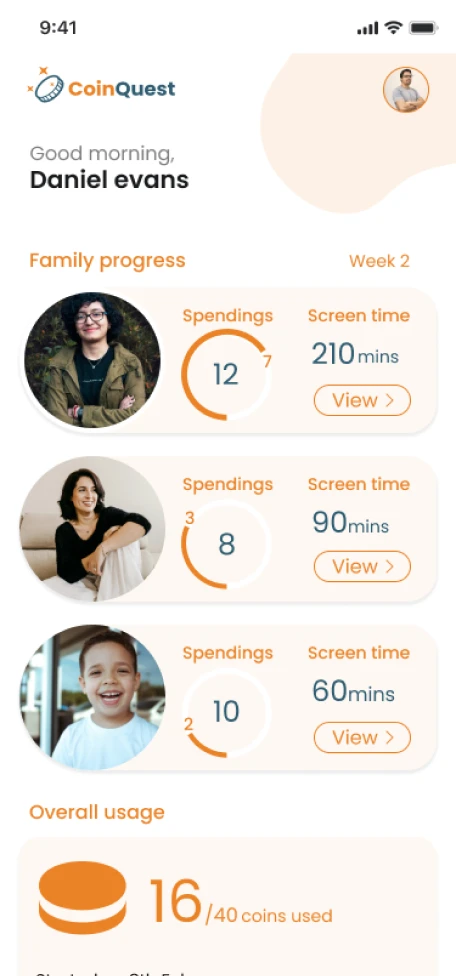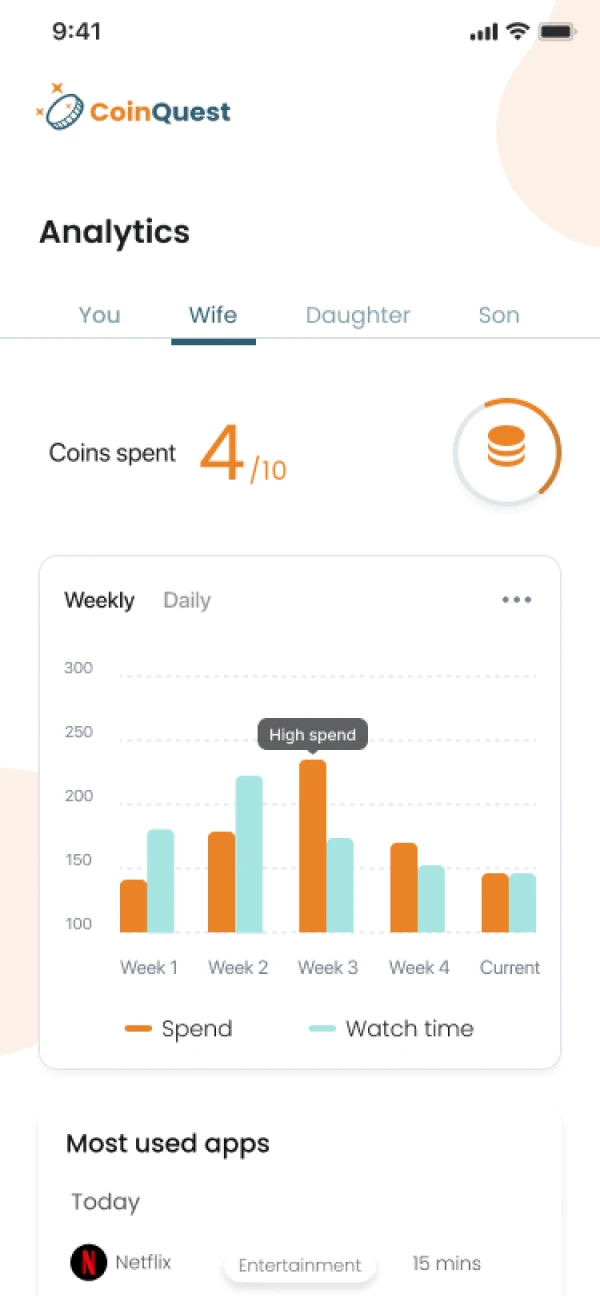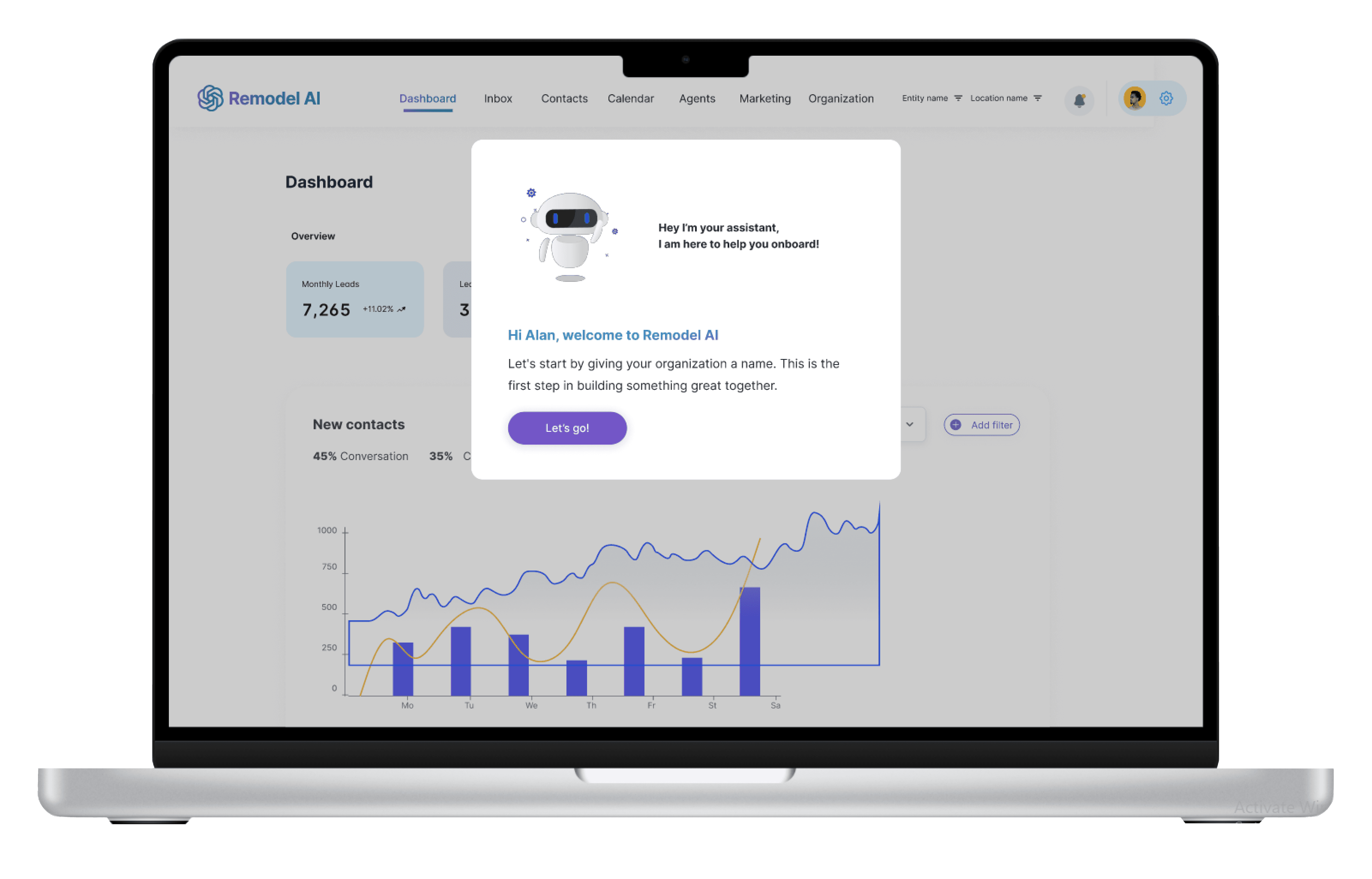Solving screen time struggles, fostering healthier family connections.
Project
CoinQuest
My Role
UX Designer, Researcher
Year
2024
Tools
Figma, Otterai, Dall-E, Gifcap.dev
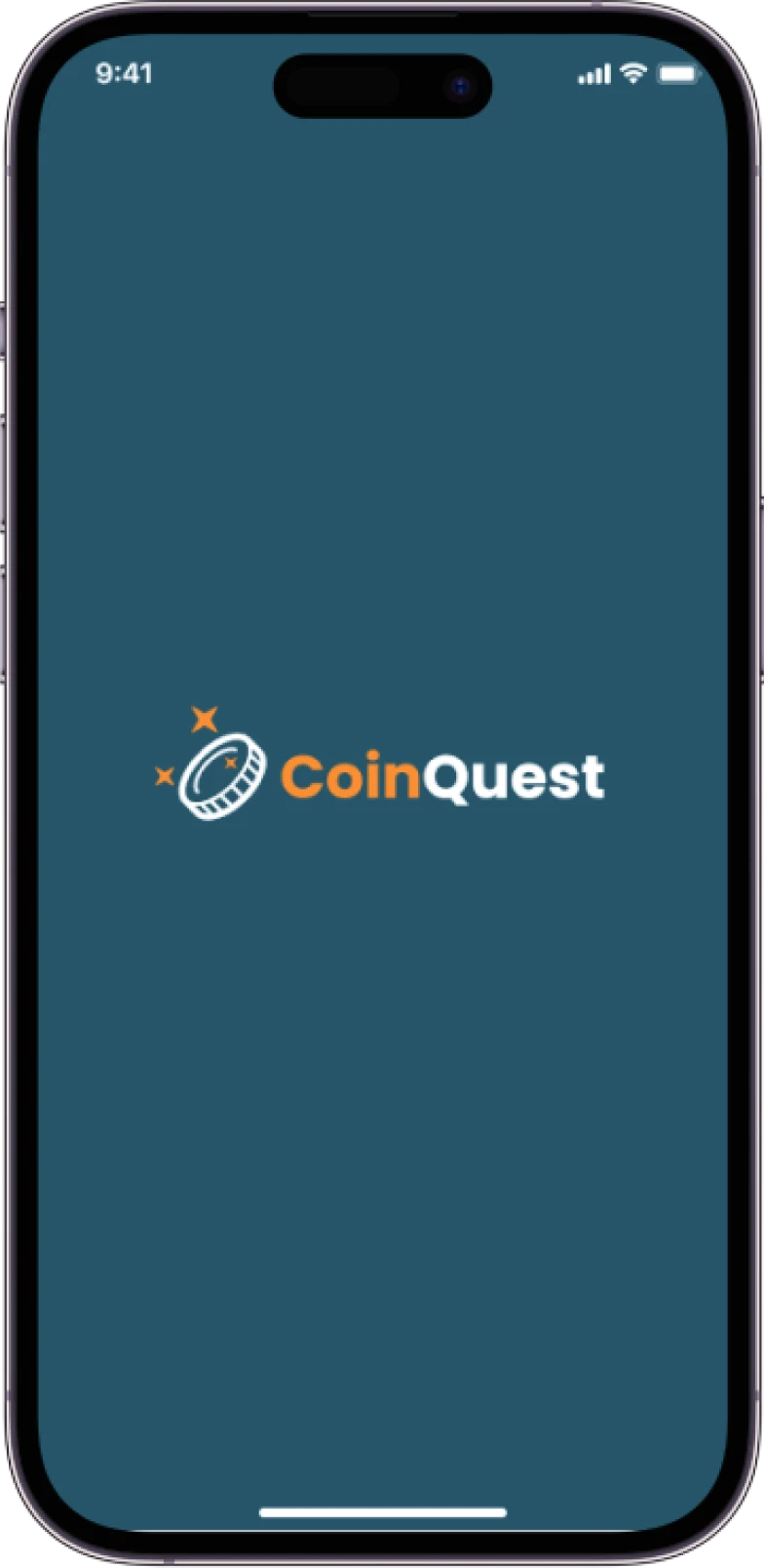
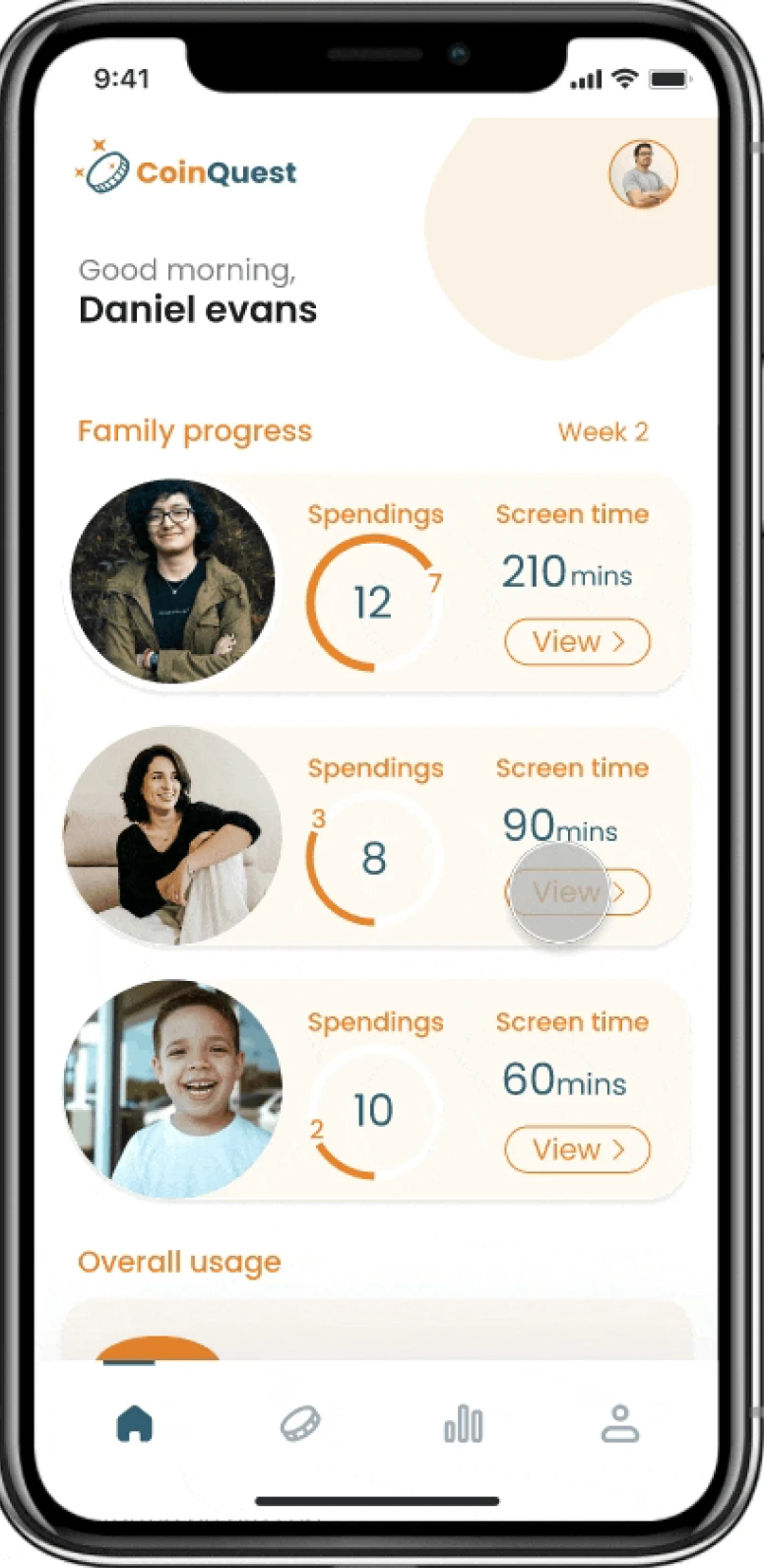
Overview
Turning Screen Time Struggles into Family Wins
CoinQuest, a project that marries fun with responsibility, helping parents and children alike build healthier digital habits. This project, developed over eight months, was part of my graduate thesis. My role spanned UX research, wireframing, gamification strategy, usability testing, and product development.
Results
Achieved outstanding usability test results after being tested with parents, offering effortless screen time management while empowering children to develop mindful digital habits
Ease Score
100%
Confidence Score
91%
Task Completion Score
100%
Highlights
Quick screen management, analytics &
rewarding family engagement -all in one app.
The problem
When screens dominate, family time often suffers
In a world where kids are constantly glued to their screens, it’s no secret that parents face a constant battle, How do we manage screen time without turning our homes into battlegrounds? As someone who has seen this struggle up close, I wanted to create a solution that doesn’t just regulate time but helps parents and kids reconnect, learn, and grow together.



Initial Research
Finding the Unknown
As I delved into the vast ocean of global data, I stumbled upon staggering statistics that echoed the fears of countless parents as they express concerns about aggressive behaviors of children linked to prolonged screen exposure.
The data says that the children with prolonged screen time are:
63%
lethargic and living a sedentary life
55%
preferring to stay alone and isolated
54%
being more aggressive and ill-mannered
43%
compromising on their academics & related skills
Secondary research
A Deep Dive into Parental Experiences
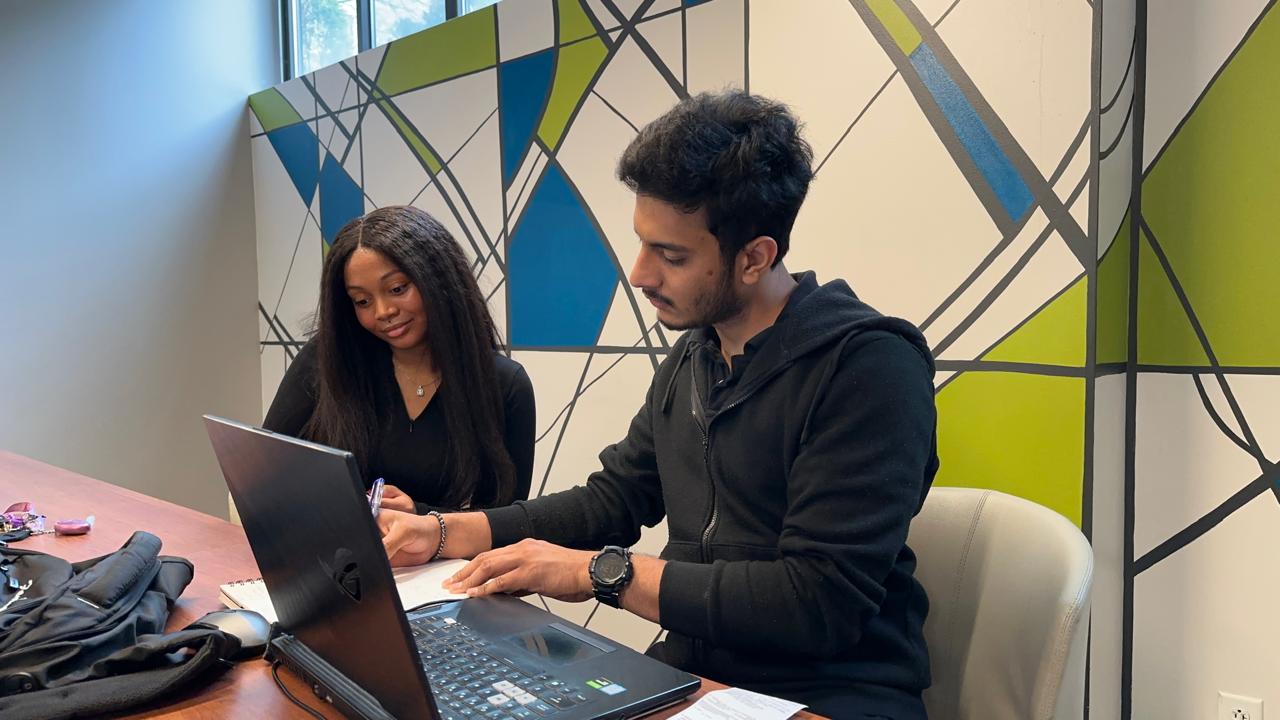
How do you typically monitor and manage your child's screen time?

What type of screens does your child use most frequently?

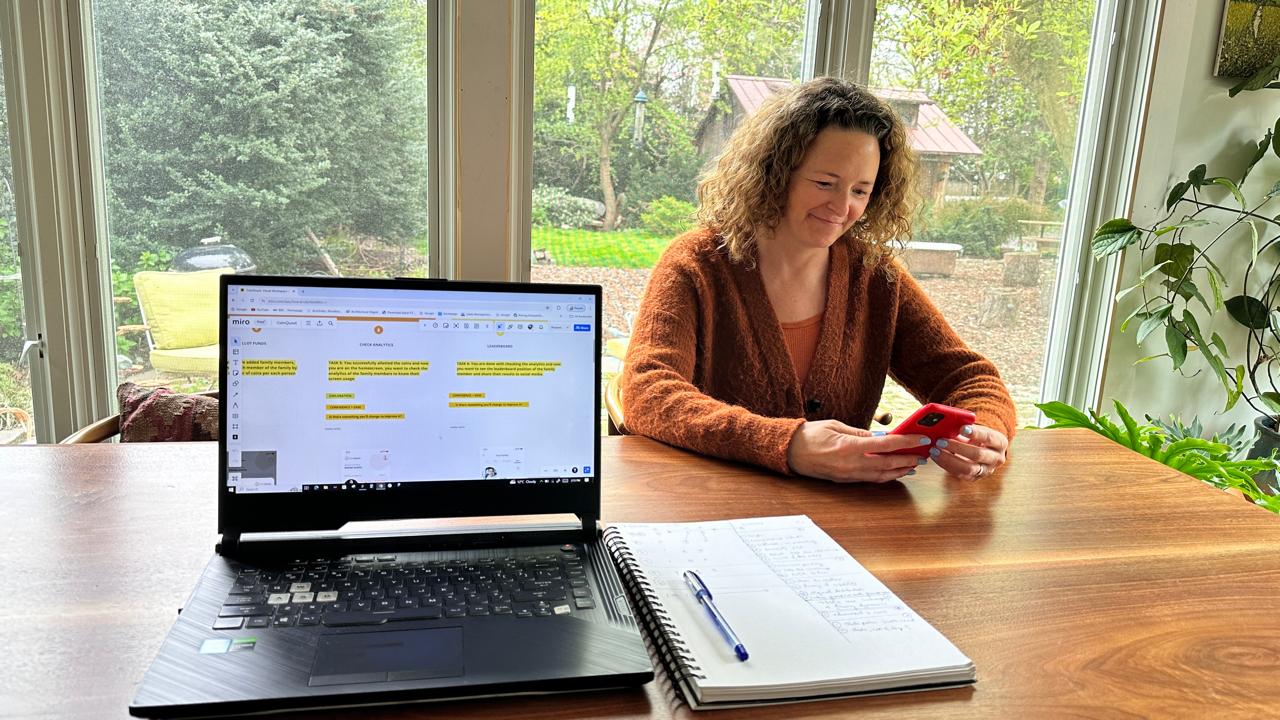
To know the root causes of the problem, I recruited around 12 parents with the children in the age of 5-12, for a one-one interview where I asked them to share their experiences managing their children’s screen time.
Through heartfelt conversations and insightful interviews, I gathered real stories and experiences managing screen time of their children.
Parents say…

Her resilience frustrates me!
“She pouts her face, sit quietly, and refuse to talk. Always with the mobile doesn't want to engage, even if it's my wife.”
Curtailing screen time is a painful
process for a parent
“As a mom, resisting my kids' screen time adds emotional complexity to my efforts. Navigating the impact on their behavior is a real challenge.”
Screen time has effects on family dynamics
“Screen time became a demand during meals at restaurants, leading to negative behavior if I don't provide a screen.”
Unfavorable outcomes of negotiating screen time limits
“I often find it hard to convince my child over screen time and he always ends up getting very frustrated, this stresses me more.”
Each story revealed a unique perspective, deepening my understanding of how this issue affects family dynamics. The insights became my guiding light, shaping the trajectory of my project and sparking ideas that would eventually lead to a groundbreaking solution.
Strategize
Understanding the “Why”- The Emotional Toll on Parents
Through these discussions, I uncovered the emotional weight that parents carry. It became evident that managing screen time isn’t just about limiting hours; it’s about understanding the underlying reasons for parental concerns over children’s behaviors.
Utilizing research methodologies, I synthesized the data collected from affinity mapping and problem tree analysis. Key findings of root causes of parental frustration while managing the child’s screen time from these insights are:
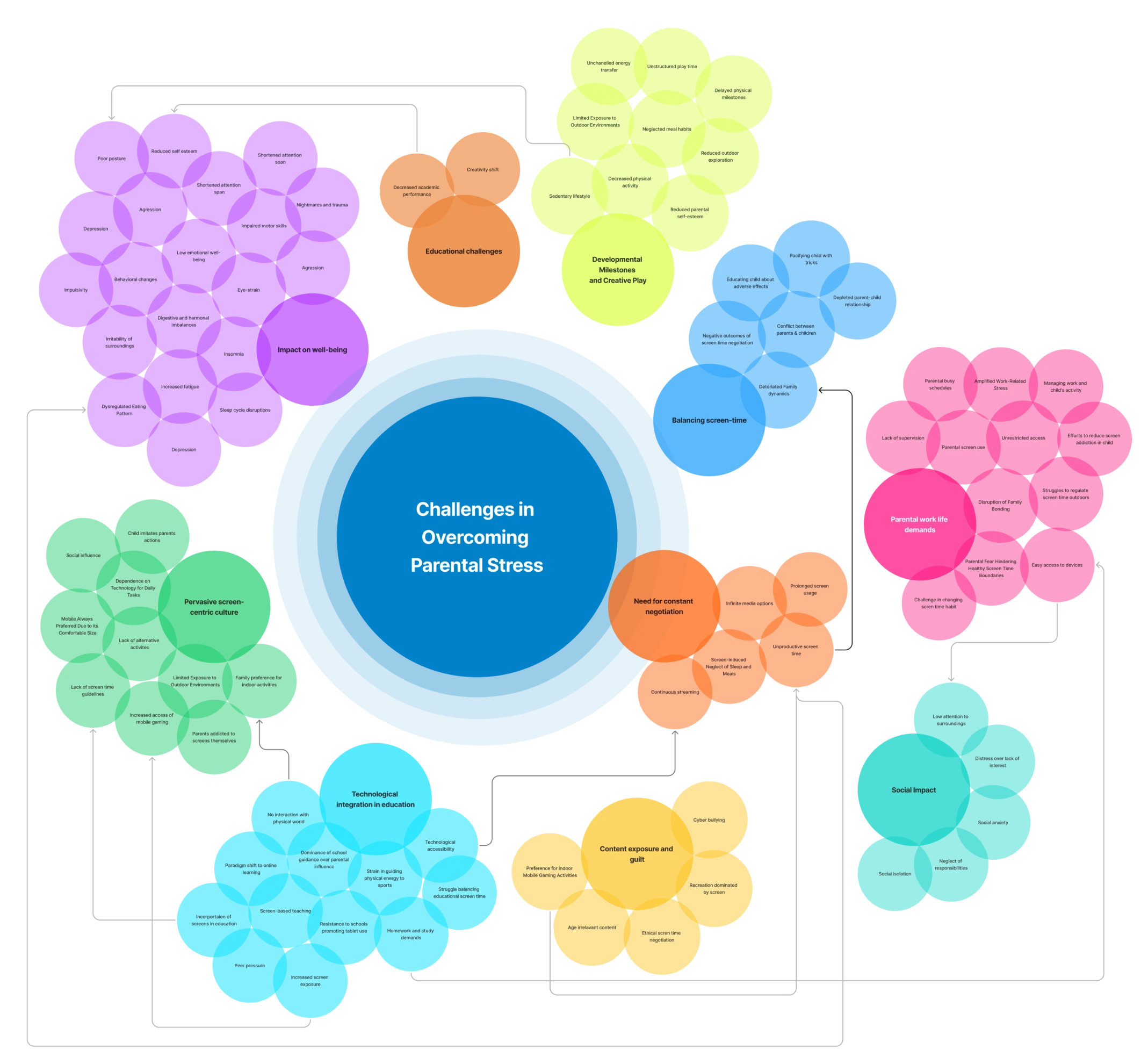
Balancing screen time
Impact on well-being
Developmental milestones
Need for constant negotiation
Parental work life demands
Social impact
Technological integration in education
Content exposure and gulit
Educational challenges
Pervasive screen-centric culture
Unveiling the Root Cause: The Screen Time Paradox
Through rigorous analysis, I realized that while some screen time is unavoidable, its unproductive nature poses the greatest threat.
I discovered that, 40% of parents felt their children used screens passively without engaging in interactive content. The challenge lies not just in limiting usage but in understanding the why behind excessive screen time.
This revelation ignited a spark—what if we could turn screen time into a rewarding experience?
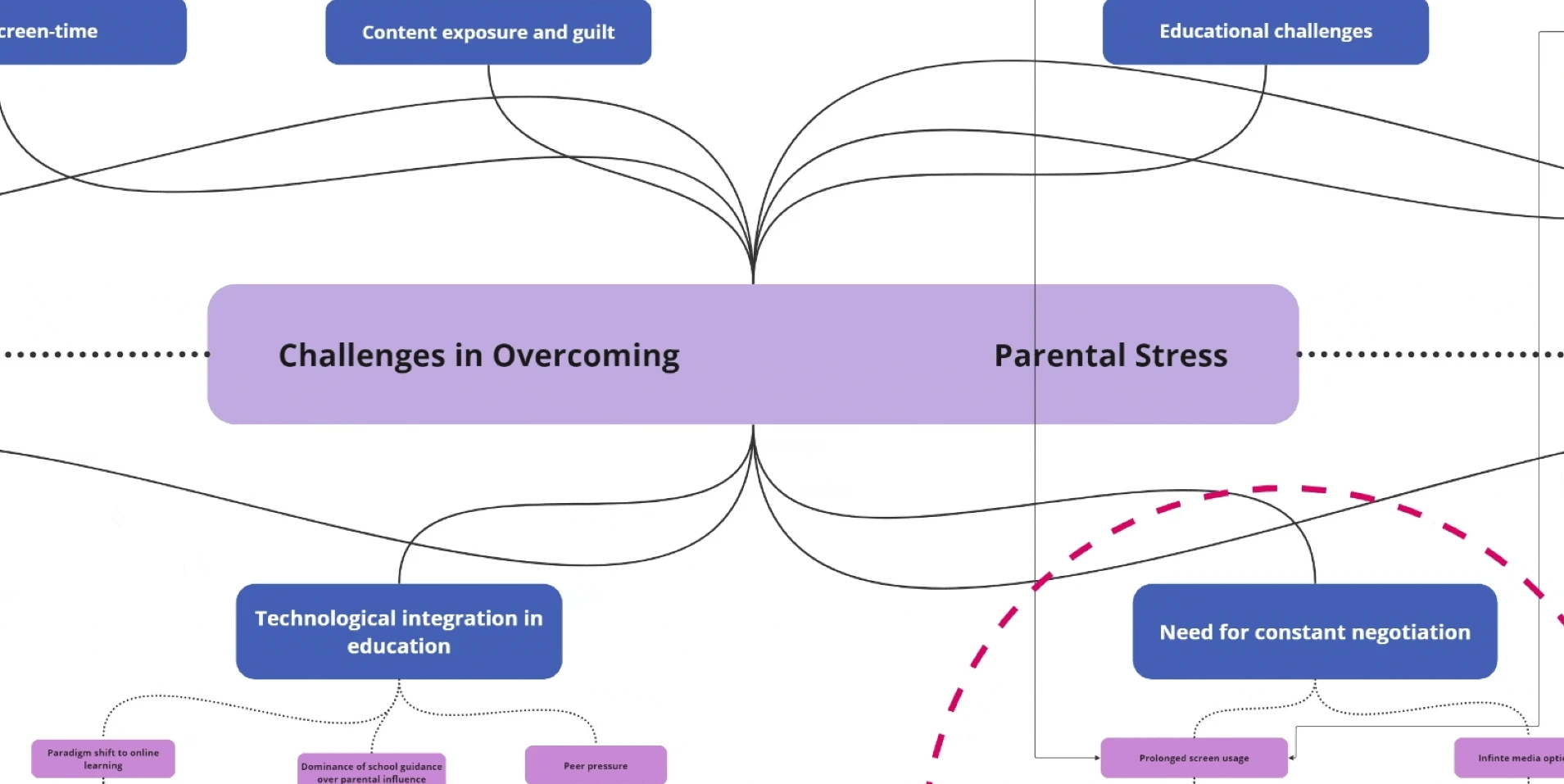
Transforming Insights into Actionable Solutions
Armed with insights and inspiration, I embarked on a mission to create a solution that would resonate with families. I meticulously noted each piece of feedback and worked diligently to develop an innovative approach that addresses the heart of the issue. My decision-making process involved:
Choosing to prioritize user feedback over preconceived notions.
Exploring gamification elements to make screen time management engaging.
My Goal
To design a platform that not only facilitates screen time management but also nurtures healthy habits, empowering both parents and children.
Challenges to Be Solved : The 3 Bridges
Empowering parents with effortless screen time management
Encourage children to develop responsible screen time habits.
Positive parent-child interaction while managing screen time.
Solution
The Transactional Nature of Parenting: A Lightbulb Moment💡
A common thread emerged from my research, children naturally respond to systems of trade and reward” This observation led me to brainstorm solutions rooted in transactional dynamics.
Path A: Continue with traditional screen time limits.
Path B: Implement a coin-based system where children could 'purchase' screen time through responsible behavior.
This epiphany opened the door to a concept I had yet to fully explore “a coin-based” system that would allow children to purchase screen time through responsibility and engagement.
Budgeting the screen time!
x 1
= 60 mins of Screen time
Testing the Concept: A Family Experiment
But theory alone wouldn’t suffice, it was time to put my idea to the test. I introduced this innovative concept to 5 families, and I have asked to deploy this concept into practice at their homes.
Earned Coins: Children earned coins for chores and responsible behavior.
Purchased Screen Time: Kids could trade their coins for screen time ( Each coin gives 60 mins of screen time permission from parents)
Mechanical turk
3 out of 5 parents set daily screen time limit for all the members in the family based on their need of screen time.
Pinocchio
4 out of 5 children are able to spend the coins in order to purchase screen time from the funds they have.
Mechanical turk
4 out of 5 parents were able to see the decreased screen time usage in the children over the period of 7 days of screen time limiting
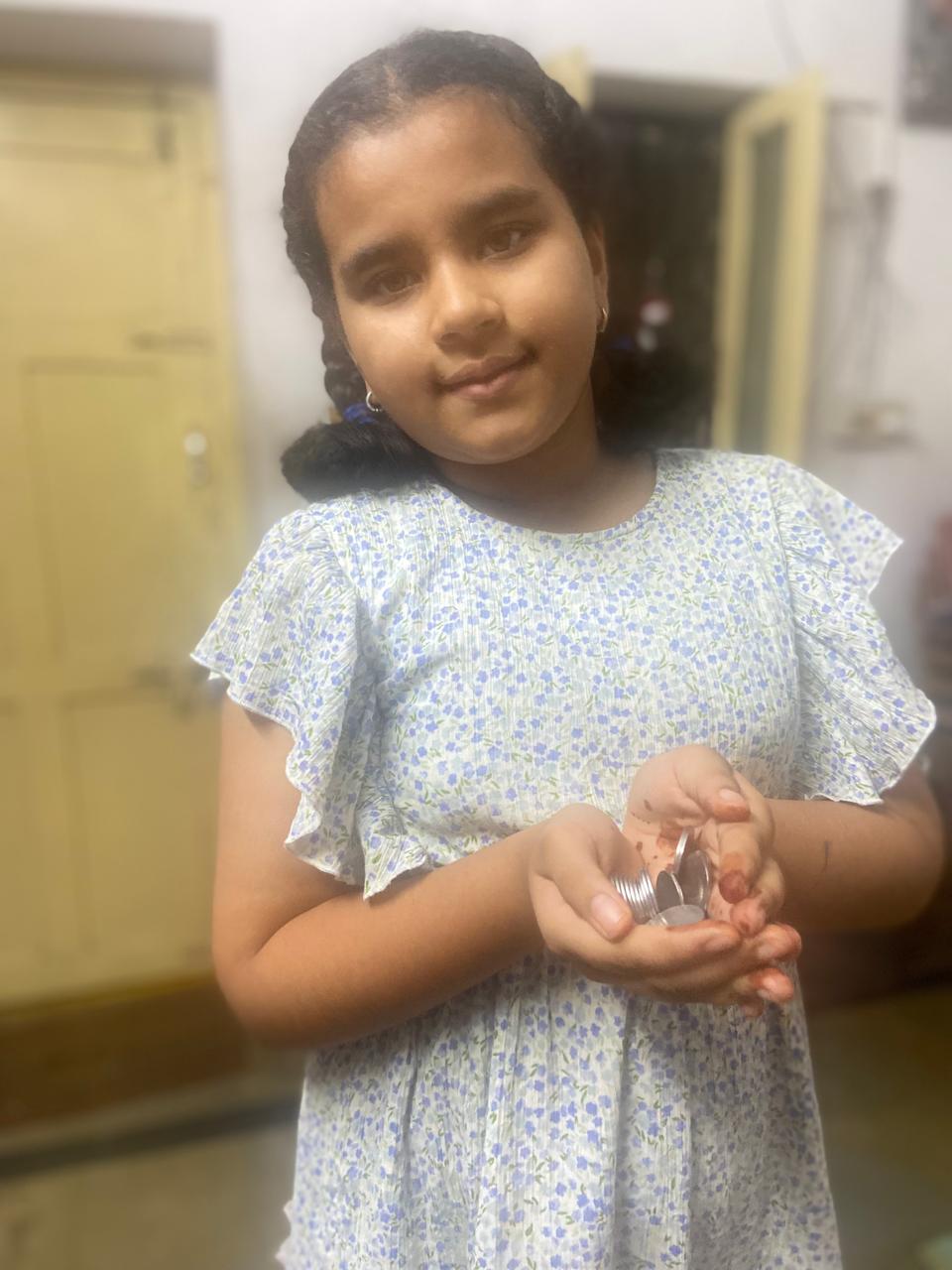
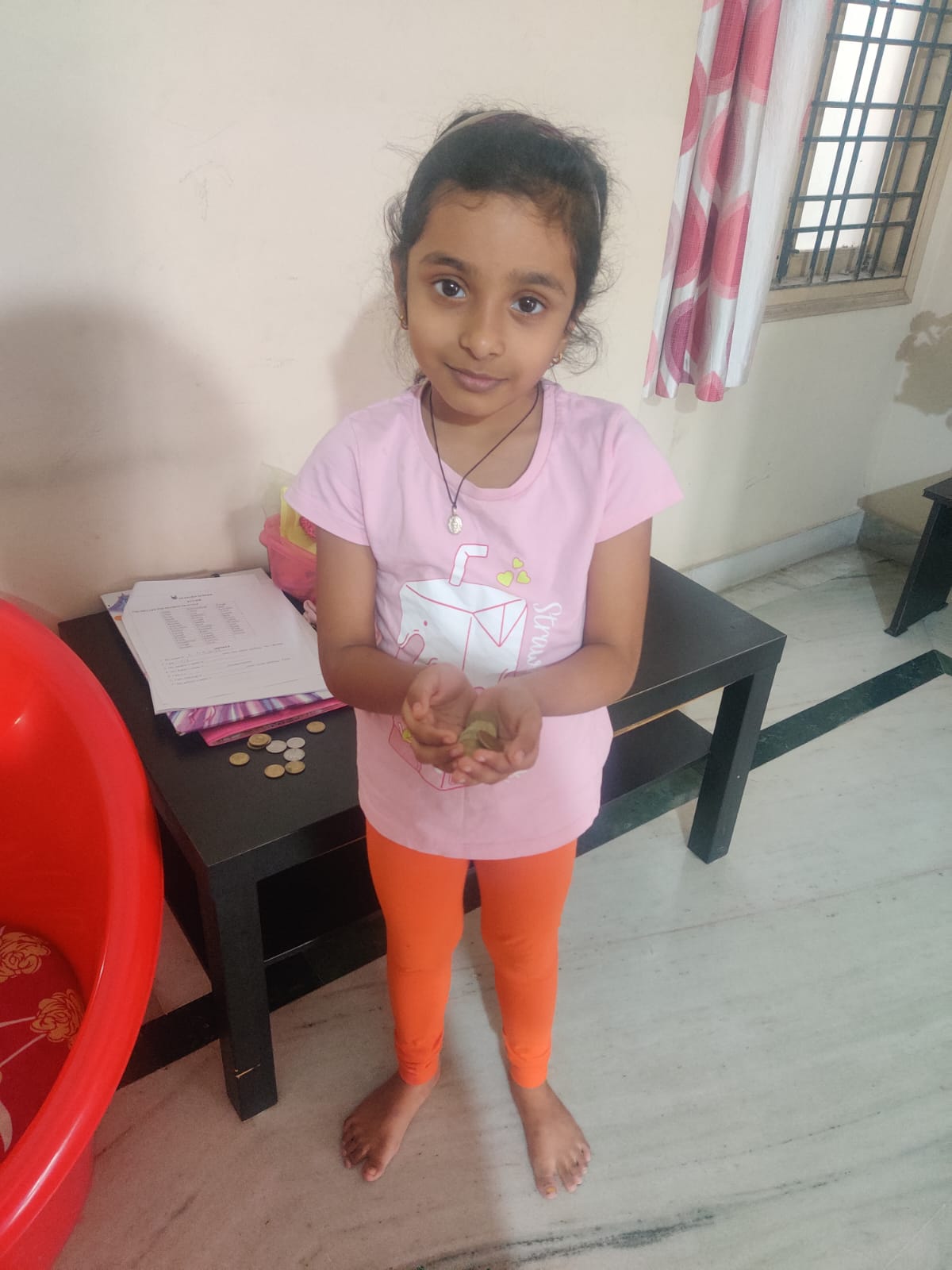
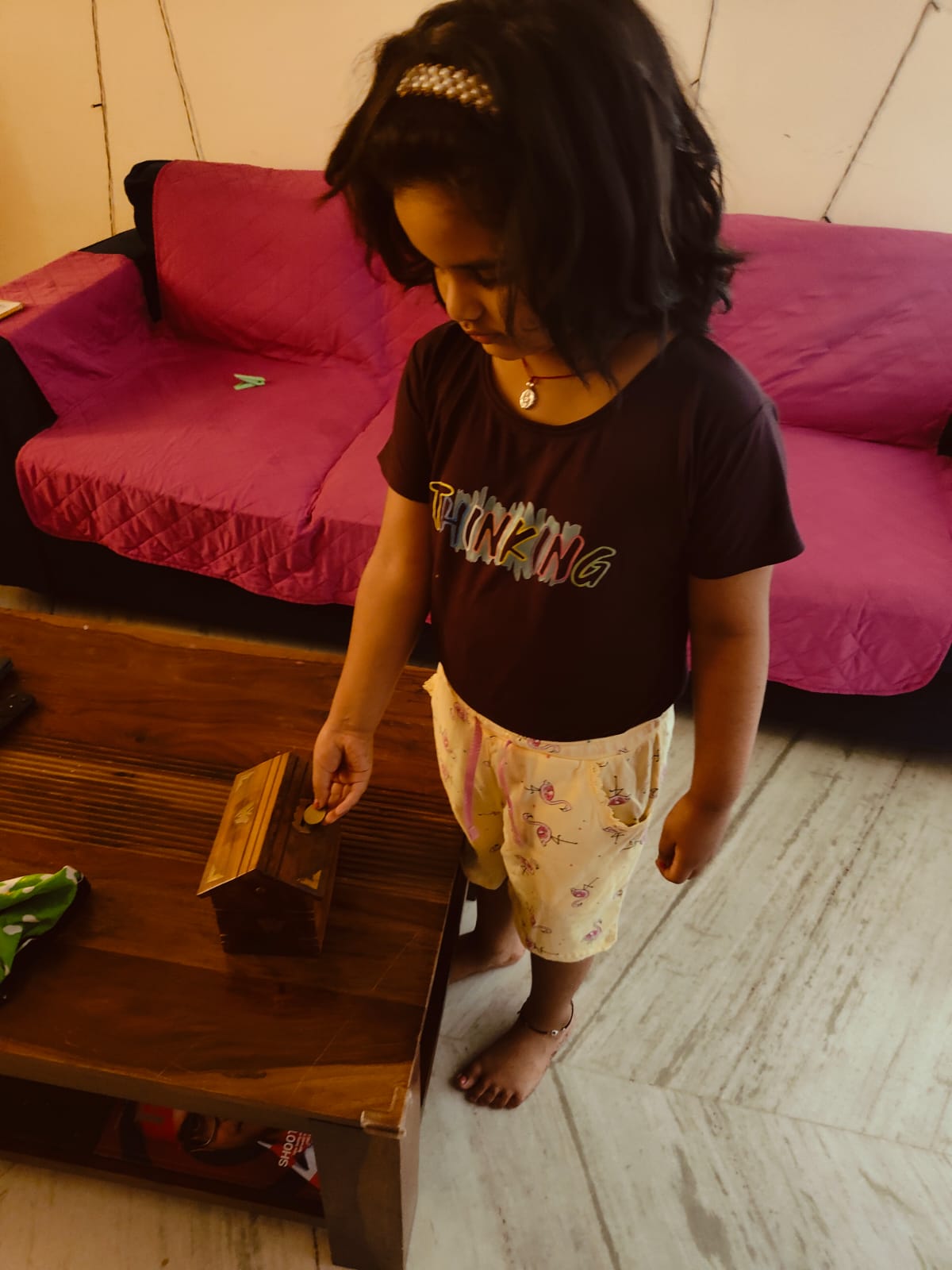
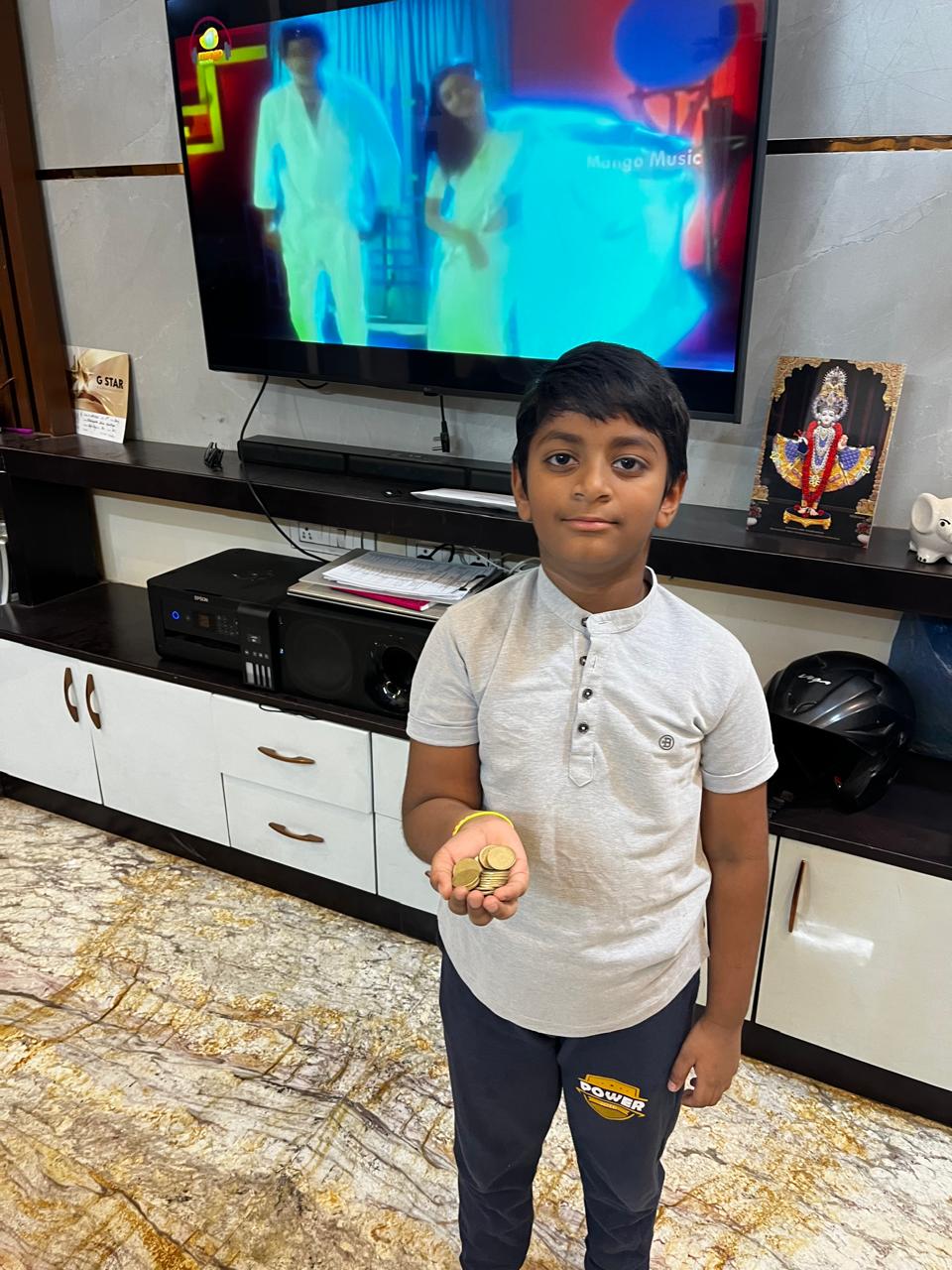
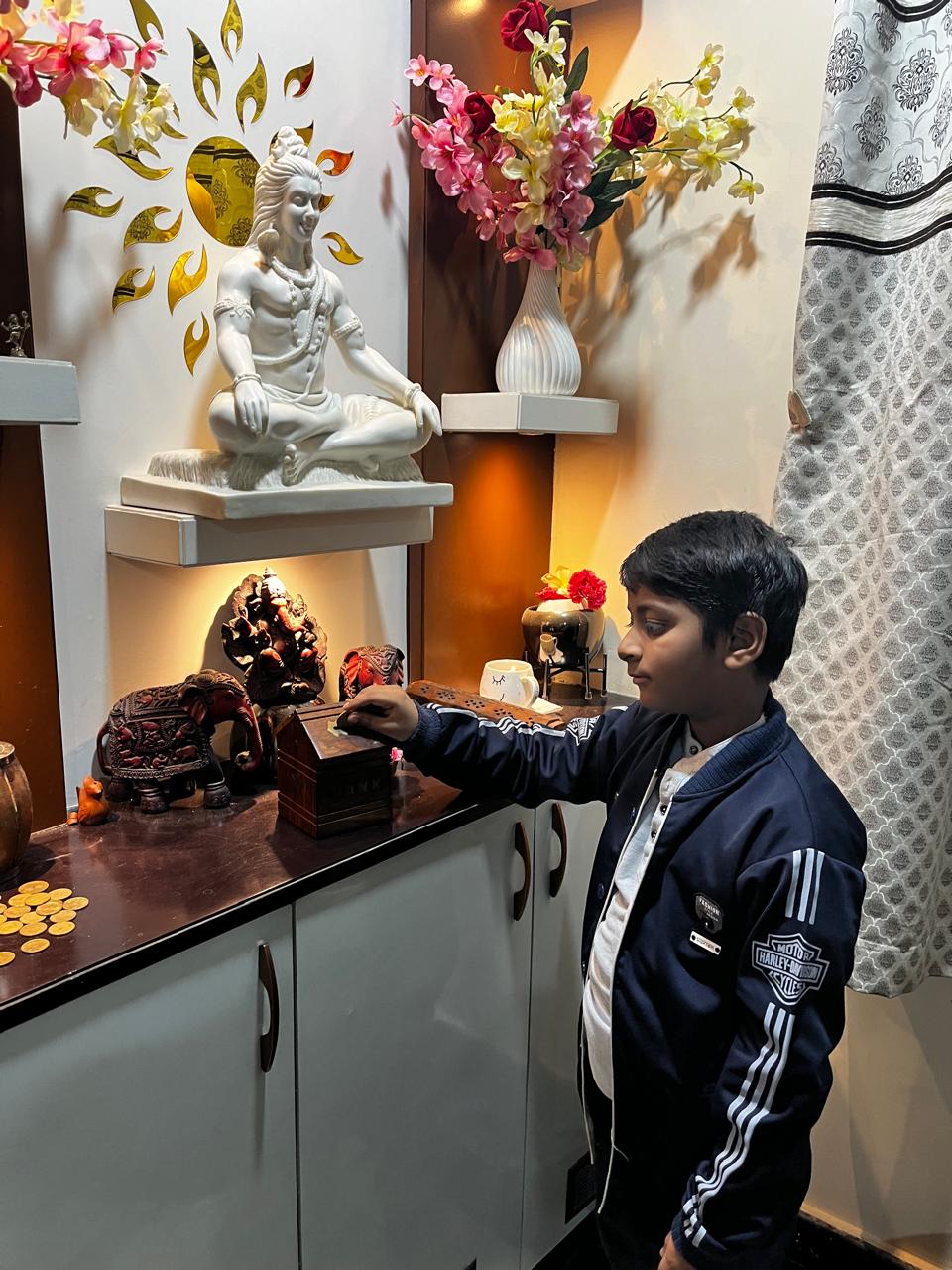
The results were astounding:
90% of children understood the concept of trading coins for screen time.
Parents noted an increase in responsibility and accountability among their kids.
Design
Developing the App: From Concept to Creation
With the success of my initial testing, I set out to create a screen time management app unlike any other.
Conducting a competitive analysis revealed a gap in the market, no existing app employed a coin-based system. This finding fueled my determination to design an innovative solution that would revolutionize how families approach screen time management.

Qustodio

Our pact

Forest app

Calm
Crafting User-Centric Designs: The Blueprint of CoinQuest
I began by creating a strory board which explains a scene of a parent using the Coinquest app and later worked on low-fidelity wireframes. The app would serve as a central hub, allowing parents to manage screen time across multiple devices while enabling children to track their coin earnings and spending.
Key features included:
Parental Control: Parents can set limits for each family member.
Coin Management: Kids can view their earnings and choose how to spend them.
This dual approach ensures that families can navigate their digital lives with clarity and control.
User Flow: Anticipating The User’s Behavioral Pattern
From the Initial trigger of opening the App, to the completion of task, the entire user journey is crafted after a careful understanding of the user needs.
The User flow is split into two paths, one for the parent and the other one for child.
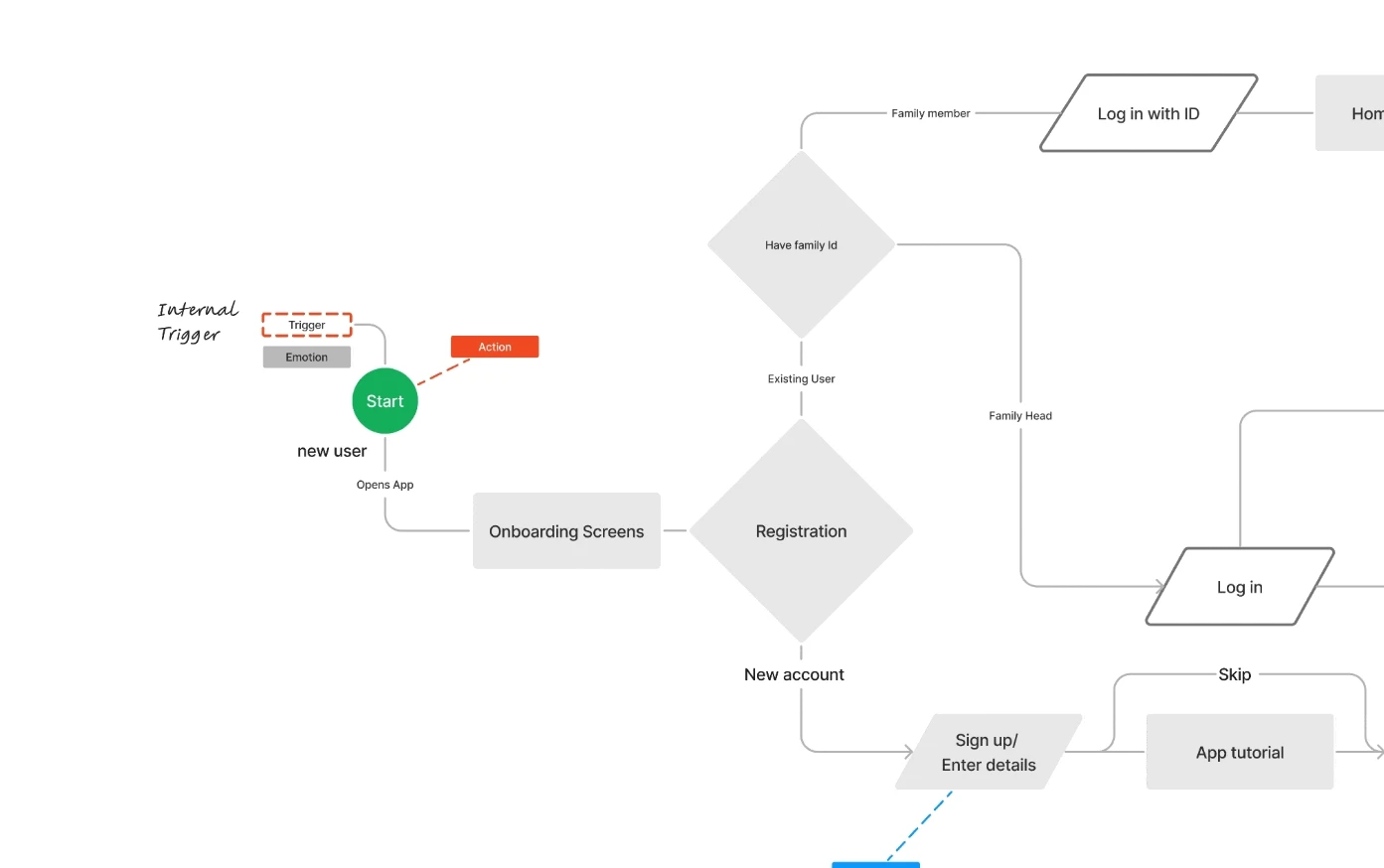
Wireframes: Initial Drawings of the App Screens
After careful consideration of the User flows, I sketched the low-fidelity wireframes for the app's major screens to test the earliest version ofthe app.
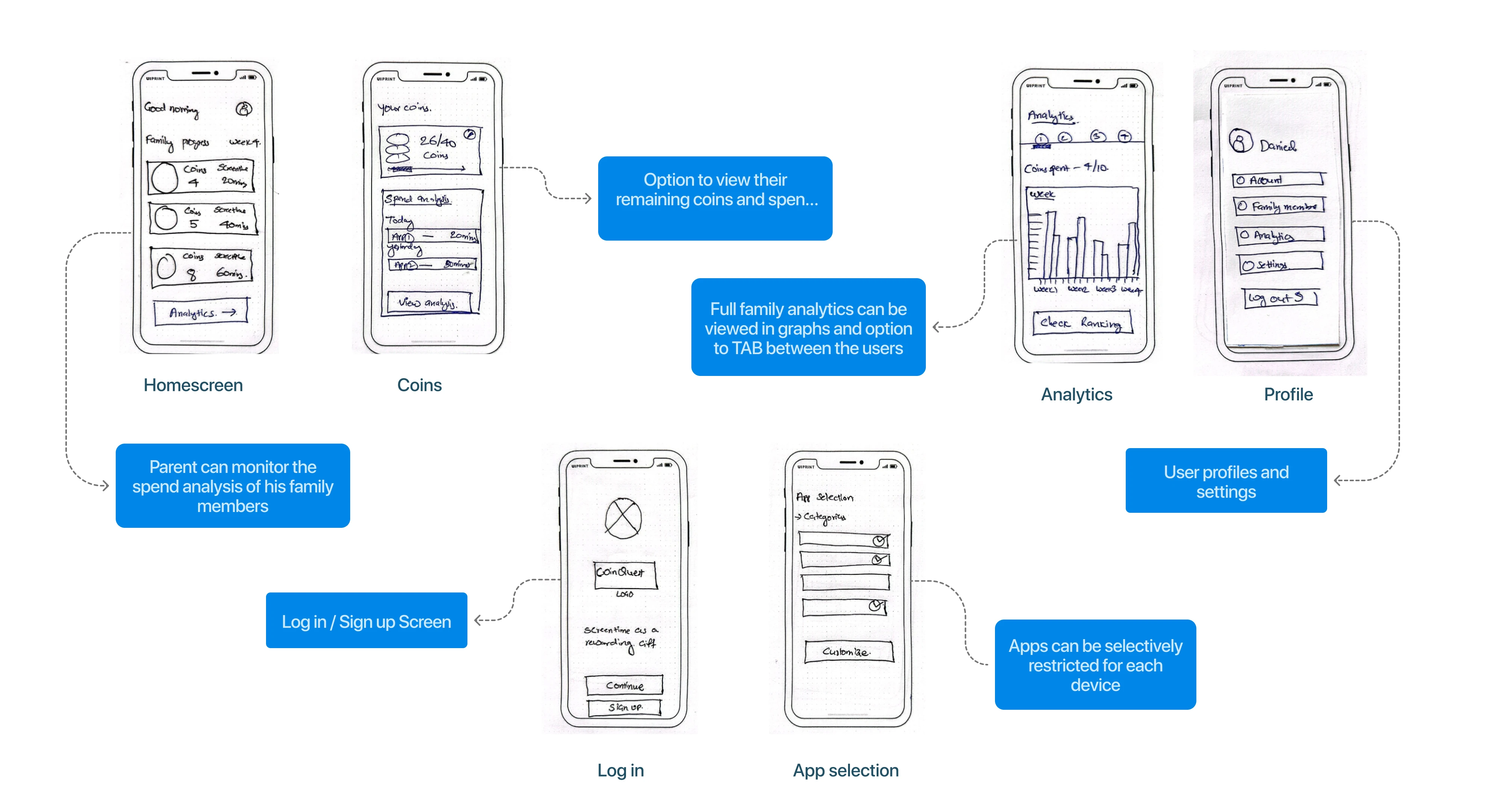
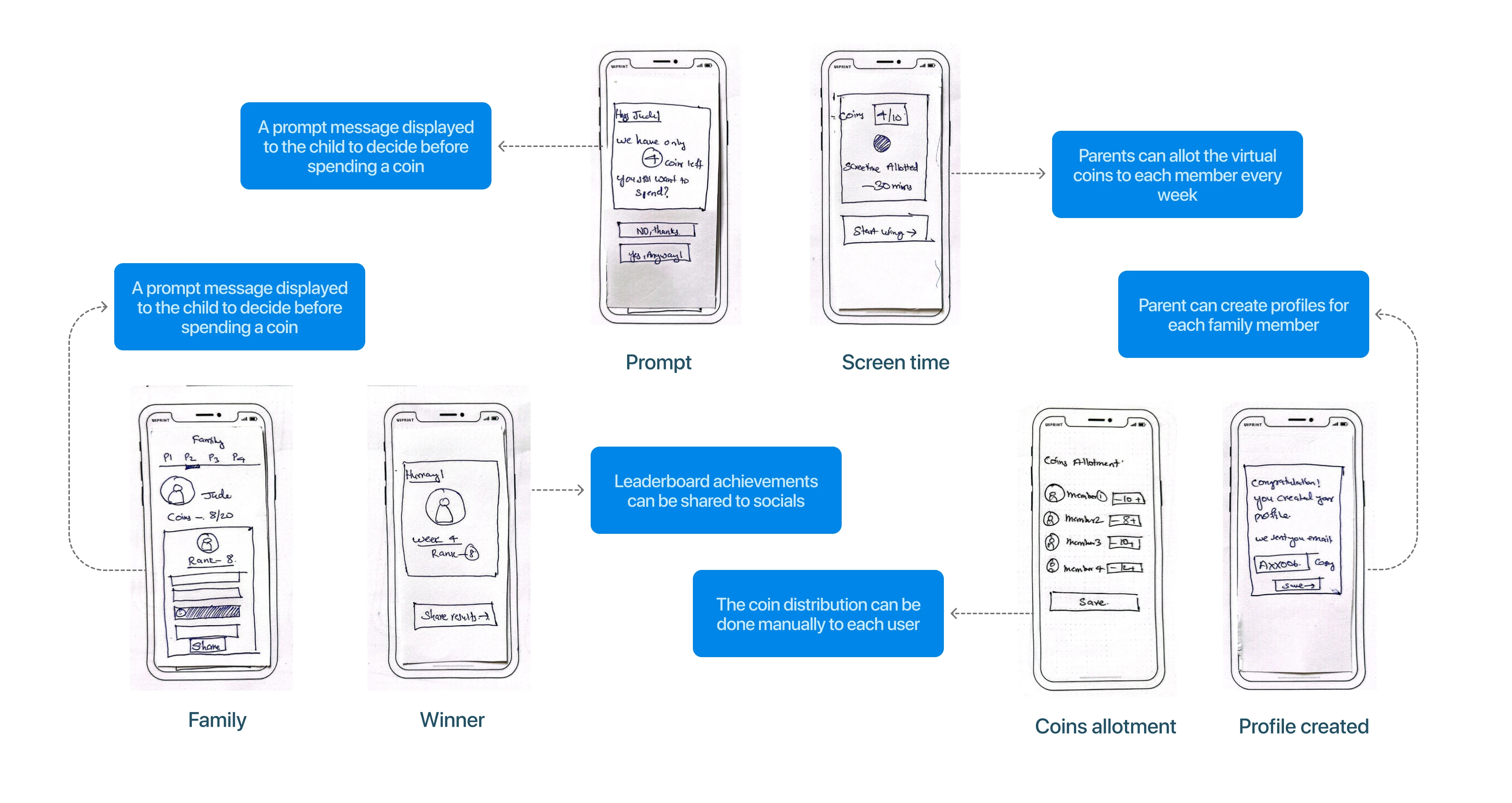
Skin of the App
The mood board for the app is set to revive the family spirit and what’s best than choosing nature and a picnic palette, where every family can relate to. The brand’s golden hue symbolizes the value of virtual coins, while the logo represents a quest—a journey to responsible screen use. This playful, yet structured design reinforces the app’s core mission.
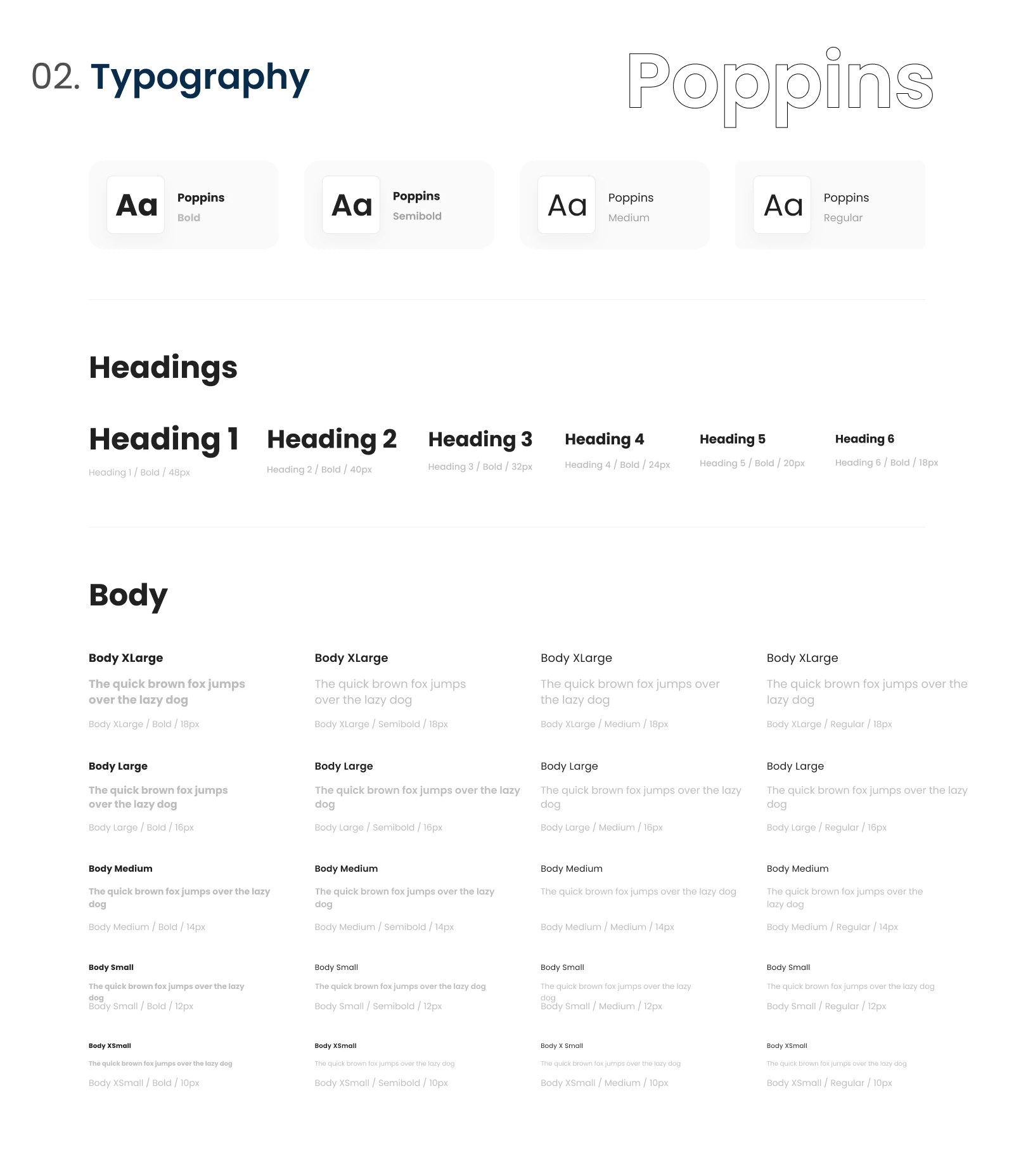
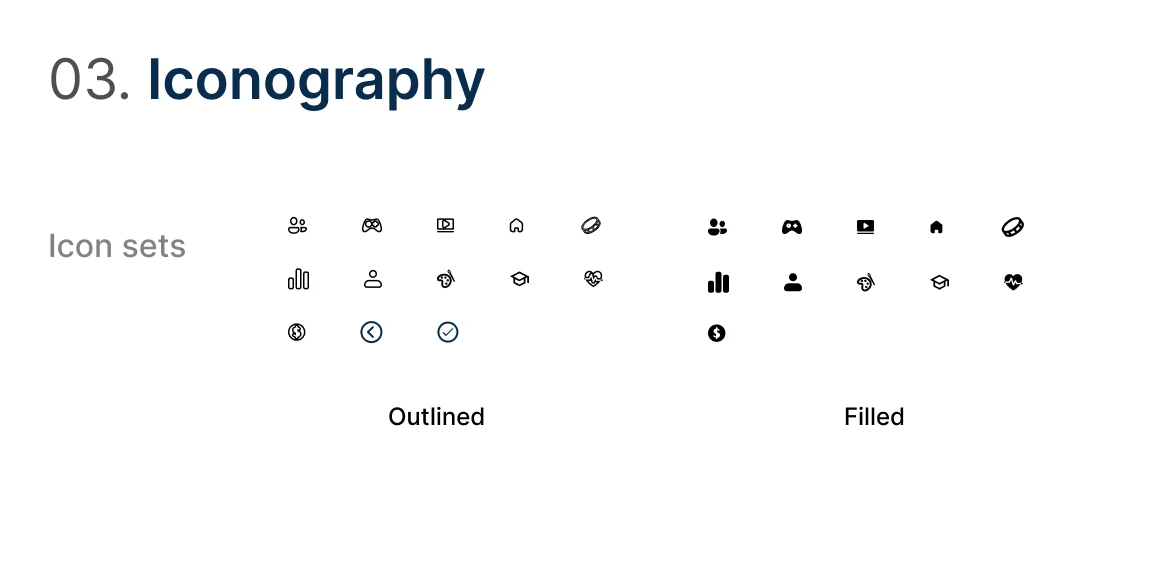


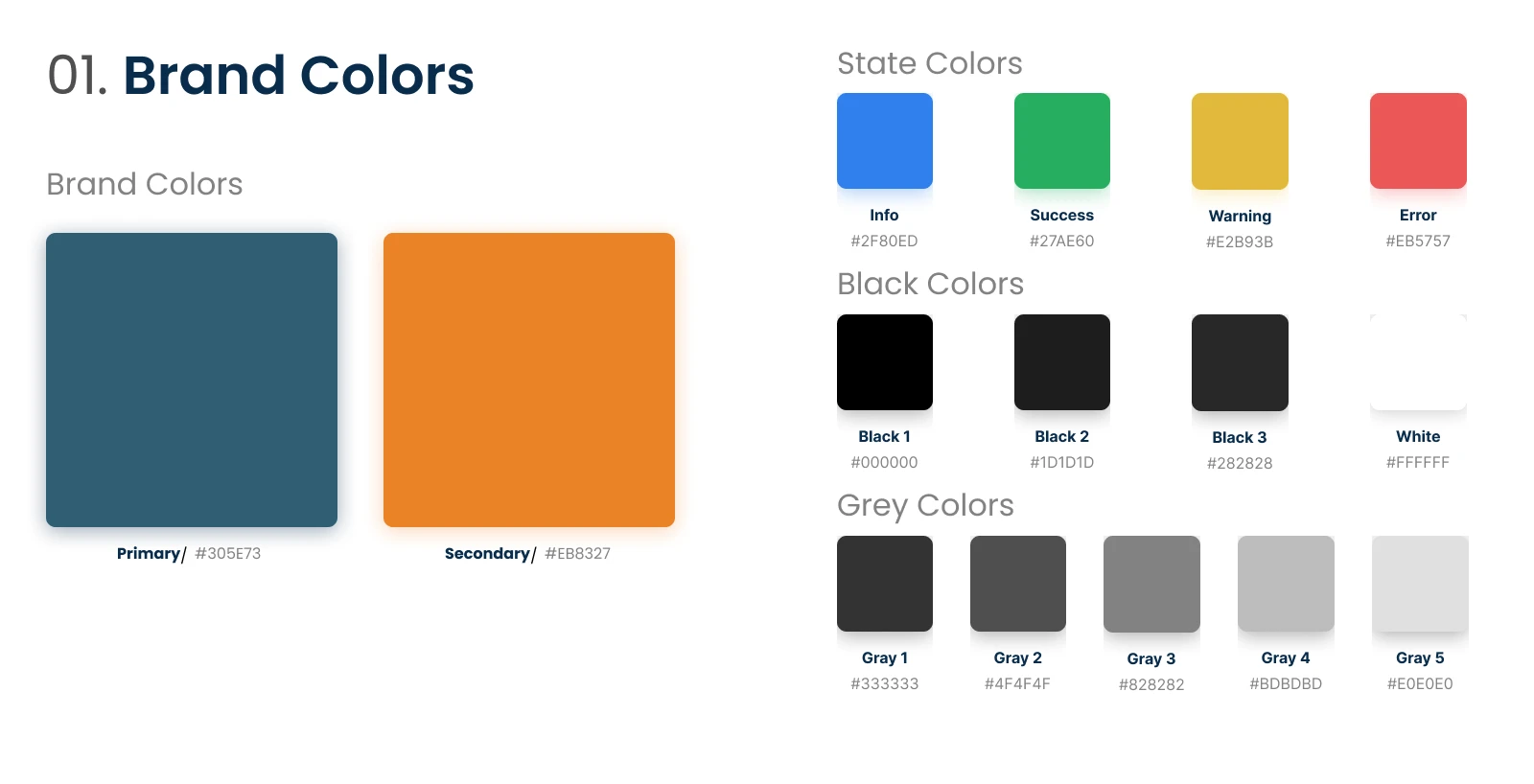
Solution
The End Game: Solving the 3 Challenges
The final part of the design process is curated to solve the 3 major challenges that I have concluded with the research and ideation. Now I translated the Lo-Fidelity wireframes into a functional UI, where the challenges were solved with minimal tasks, using Figma.
Challenge 1 - Empowering Parents with Effortless Screen Time Management
Empowering parents with intuitive tools for easy screen time management alleviates stress while fostering a positive digital environment for their children.
Desk Study:
Research shows that parents often feel overwhelmed managing their children's screen time, leading to frustration and guilt due to unclear limits and user-unfriendly solutions
Interview Insights:
"I wish there was an easier way to set limits without having to go through the complicate process of my child's screen usage.”
Feature:
Monitor Spend Analysis
Avail virtual coins - Create family profiles - Allocate coins - Check Analytics - Share leaderboards
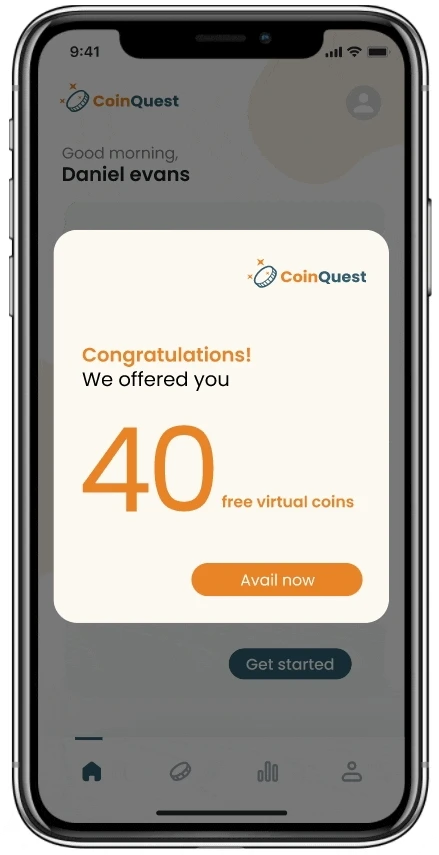
Avail virtual coins
Parents can easily access virtual coins through the app, empowering them to manage and distribute screen time for their children efficiently.
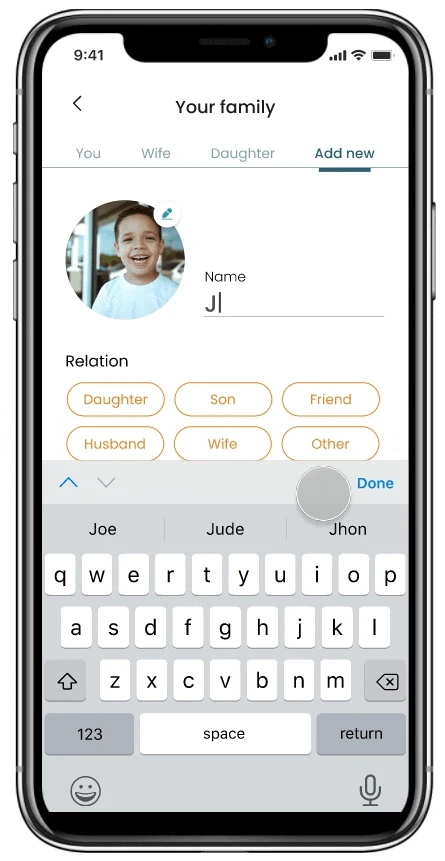
Create Family Profiles
Set up personalized profiles for each family member to track individual screen time usage and tailor the experience to fit their needs.
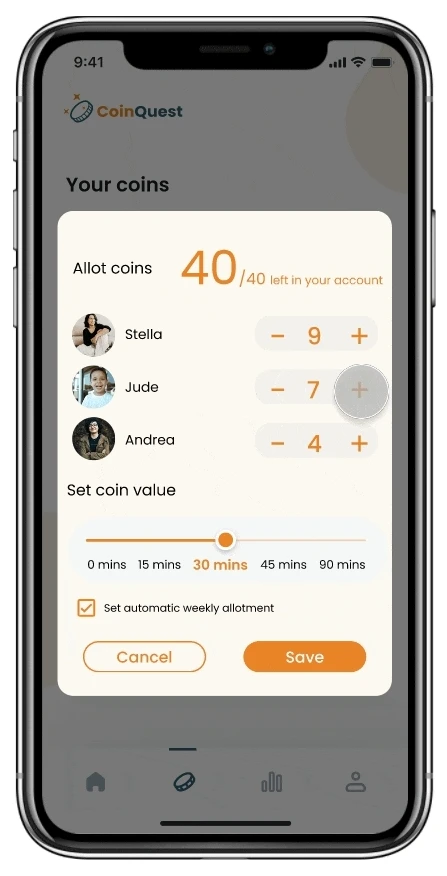
Allot virtual coins
Distribute virtual coins at the start of the week, allowing parents to set clear screen time limits and encourage mindful usage.
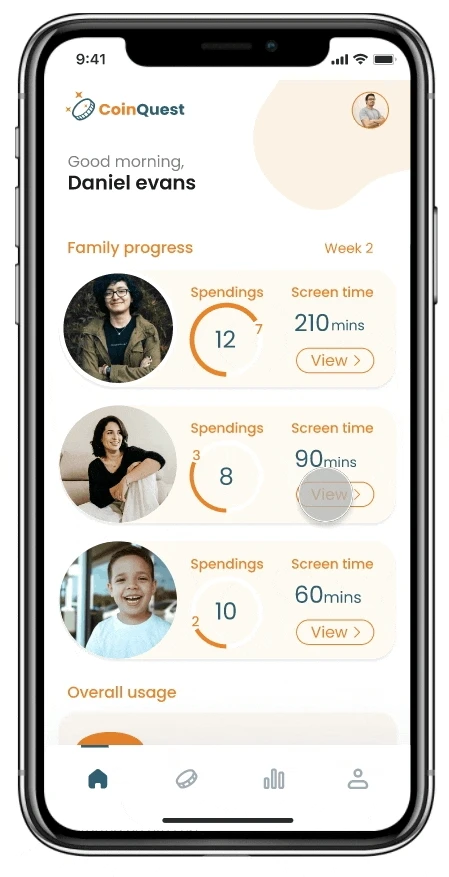
1
Parents seamlessly monitor and review screen time activity
Monitor detailed usage reports with family screen time analytics, helping parents stay informed about their children's digital habits.
Challenge 2 : Encourage children to develop responsible screen time habits.
Developing responsible screen time habits helps instill self-regulation and mindfulness. Encouraging discussions about their choices fosters a healthy relationship with technology.
Desk Study:
Children need guidance and tools that empower them to take ownership of their usage. Studies show that children who actively participate in managing their screen time develop a better understanding of balance and responsibility.
Interview Insights:
"I want my kids to learn how to balance their screen time in a responsible way and have healthier habits."
Feature:
Virtual Coins for Screen Time
Analyse prompt message - Choose to spend or revert - Educational screen time - Score leaderboards
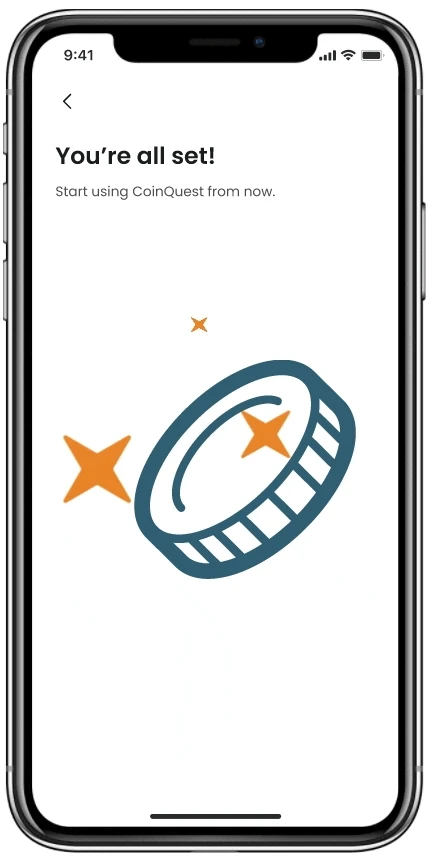
2
Children Spend Virtual Coins for Screen Time
Kids can exchange coins for designated screen time hours, helping them understand the value of limiting the usage of resources.


Prompt Warning
When children try to open an app, they see a prompt set by their parents, reminding them of the screen time limit and coins available.
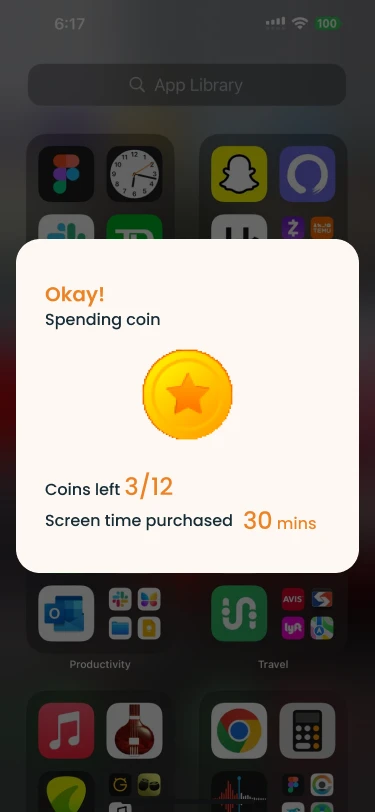

Virtual Coin Animation
This feature encourages children to reflect on their screen time choices and promotes responsible digital behavior and limit spending.
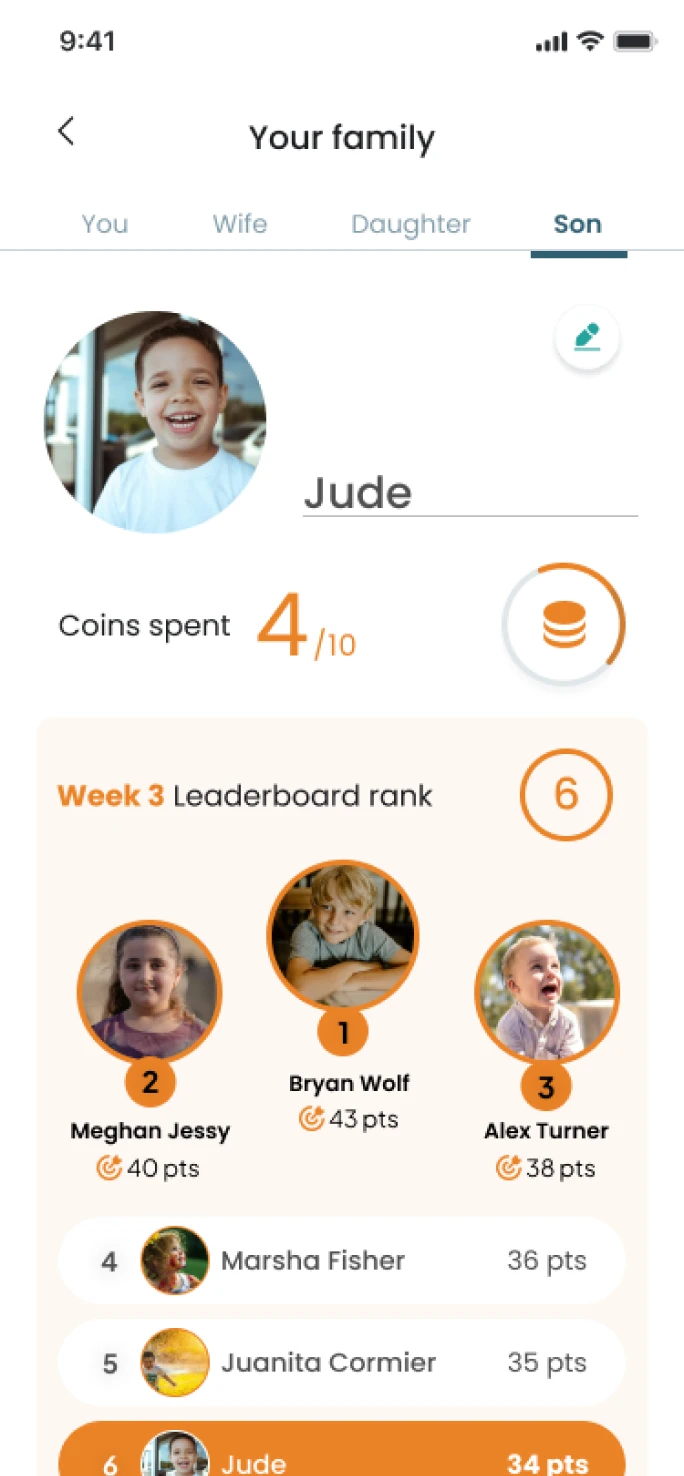

Leaderboard Results
The leaderboard reflects the children's responsible screen time habits by rewarding points for wisely spending coins on educational content.
Challenge 3 : Positive Parent-Child Interaction While Managing Screen Time
Parents foster pride and reinforce responsible screen time habits, creating a supportive environment that enhances positive parent-child interaction.
Desk Study:
Effective communication about screen time can enhance parent-child relationships and promote healthier habits, as families who discuss screen time are more likely to establish mutual understanding and respect for boundaries.
Interview Insights:
"I want to ensure my kids about positive results of screen time habits instead of just enforcing rules."
Feature:
Leaderboard Ranking
Check screen time analytics - Configure spend analysis - Check leaderboard - Share results
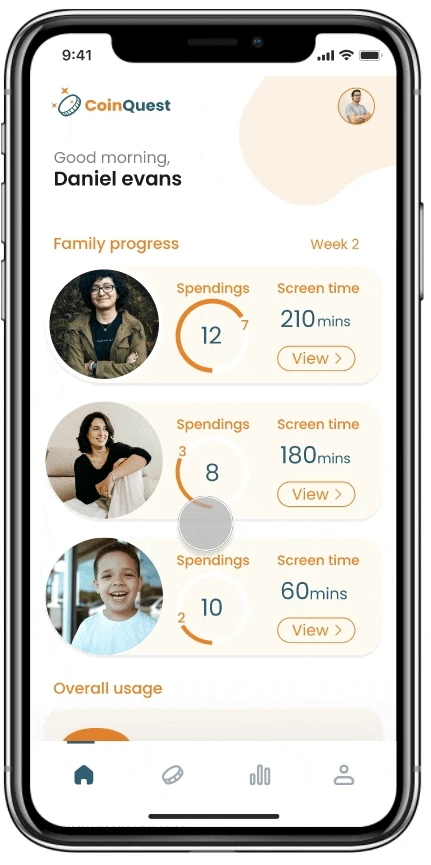
3
Parents share leaderboards results
Parents share their child's leaderboard results, celebrating achievements and encouraging responsible screen time management.
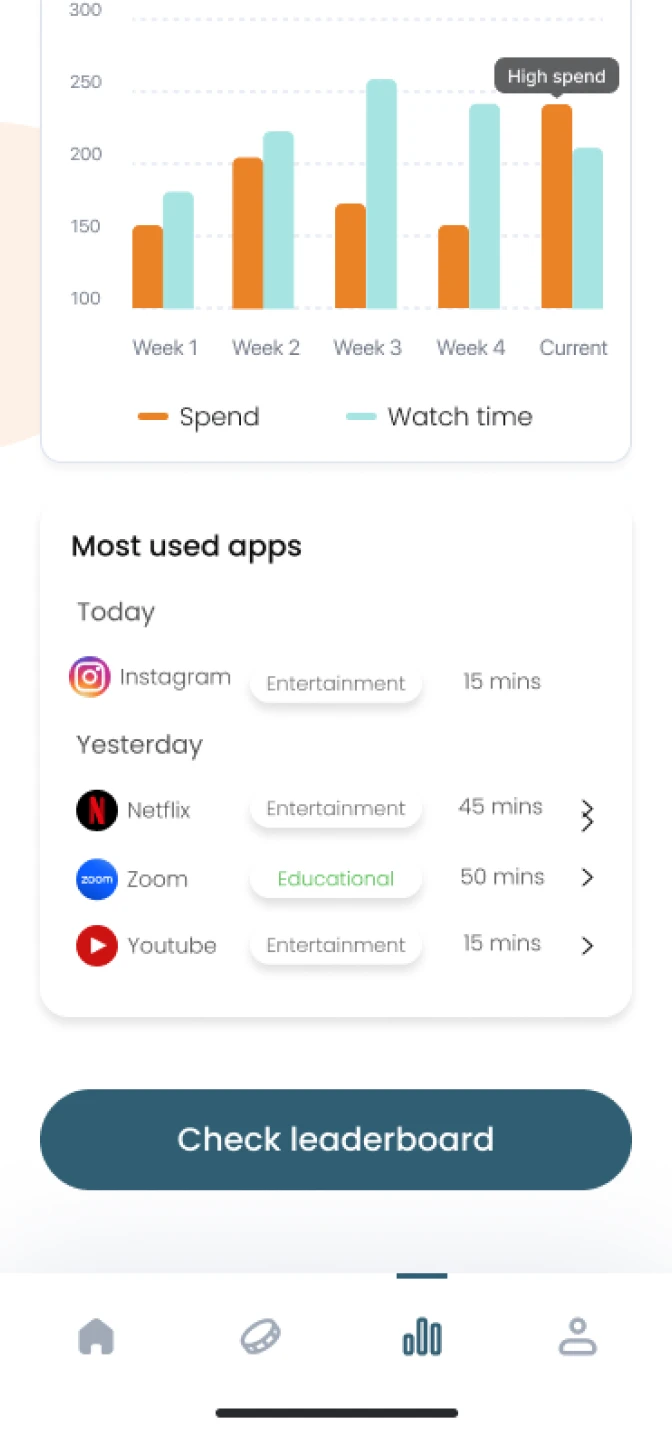

Most Used Apps
Parents can easily monitor their child's most used apps and where they spent most coins to ensure balanced screen time and healthy habits.
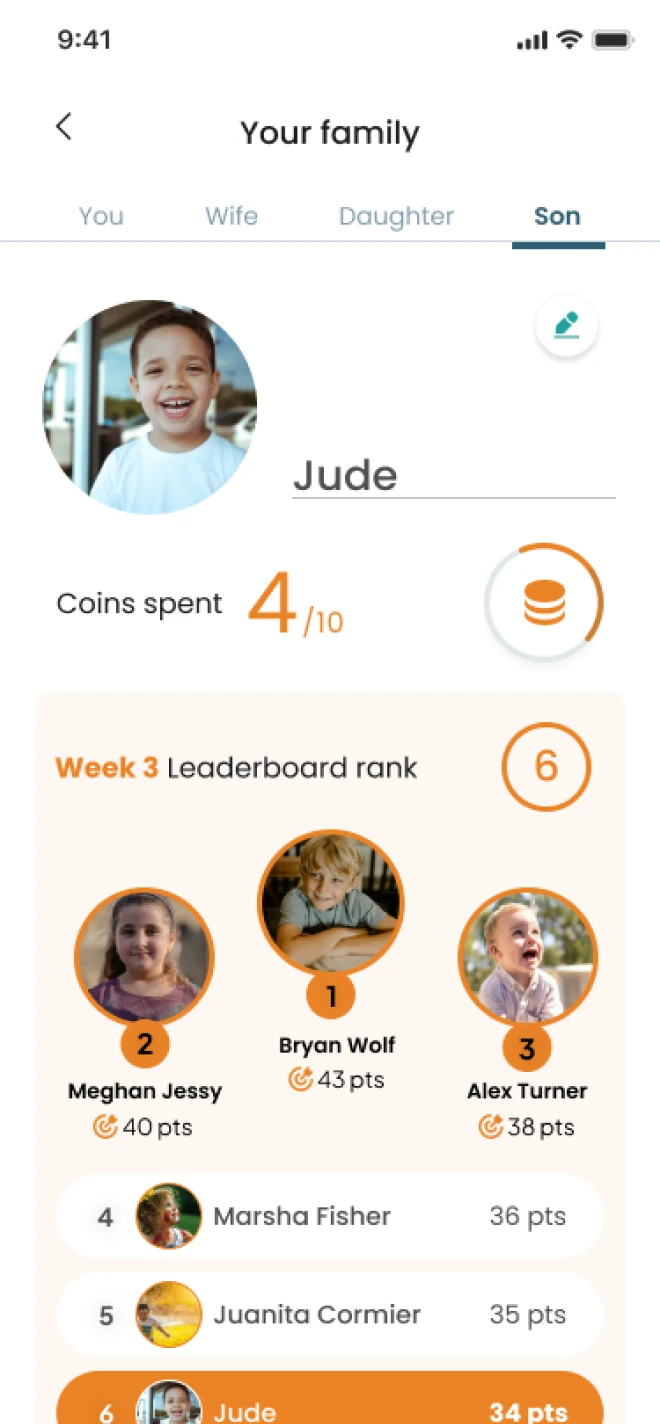

Leaderboard Results
The leaderboard reflects the children's responsible screen time habits by rewarding points for wisely spending coins on educational content.
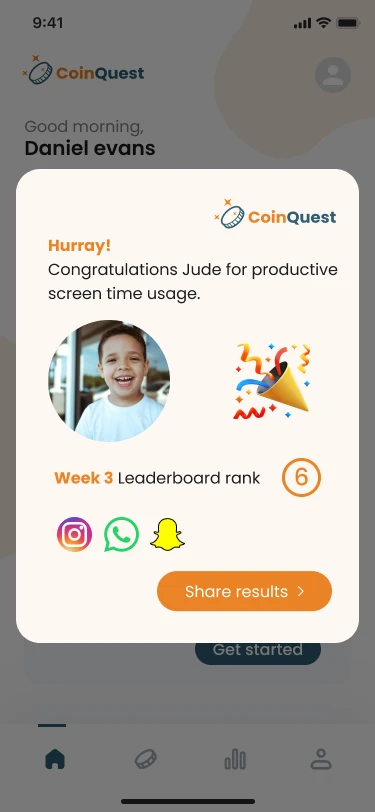

Share Results
Parents can proudly share their child’s leaderboard results on socials, highlighting achievements fostering a sense of accomplishment.
Usability Testing
The Last Test: Usability
After sharing the App prototype, I asked participants to provide ratings for their experience in terms of Ease and Confidence for each task, using a scale of 0 to 5, where 0 denoted the lowest and 5 the highest level. The success score was determined based on my assessment of task completion or failure.
Successful Results:
Users were successfully able to complete all the given tasks with the scores as mentioned:
Ease score being 100%
Confidence score 91% and
Task completion score 100%
Below is a graphical representation of the avg. scores across the five users.
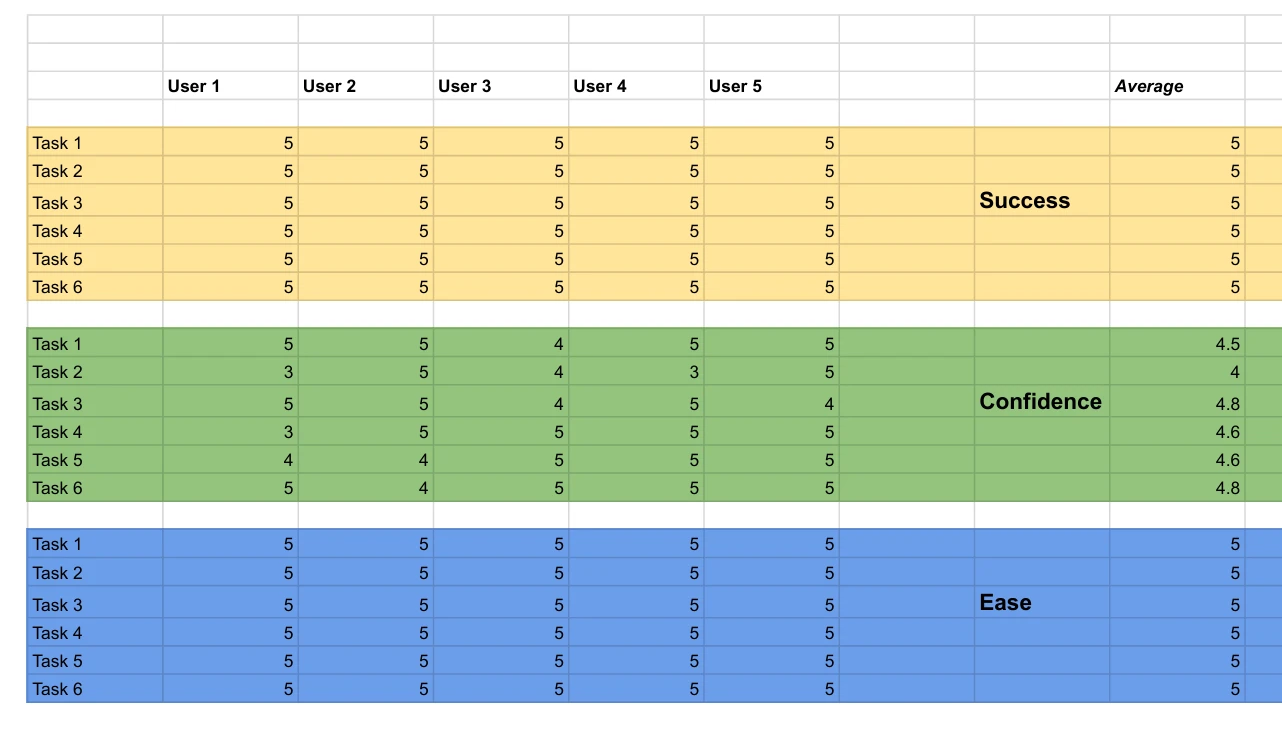
Ease score
100%
Confidence score
91%
Task completion score
100%
No. of participants
5
Total testing minutes
200+
Total tasks
30
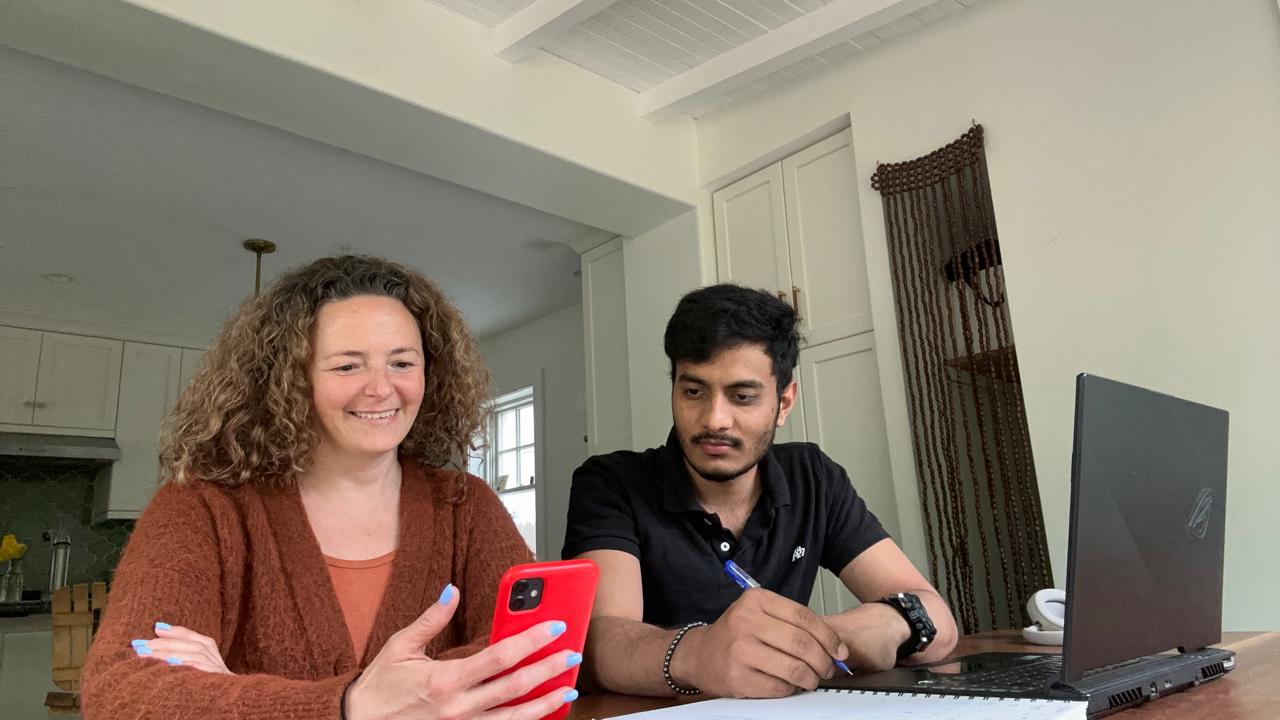
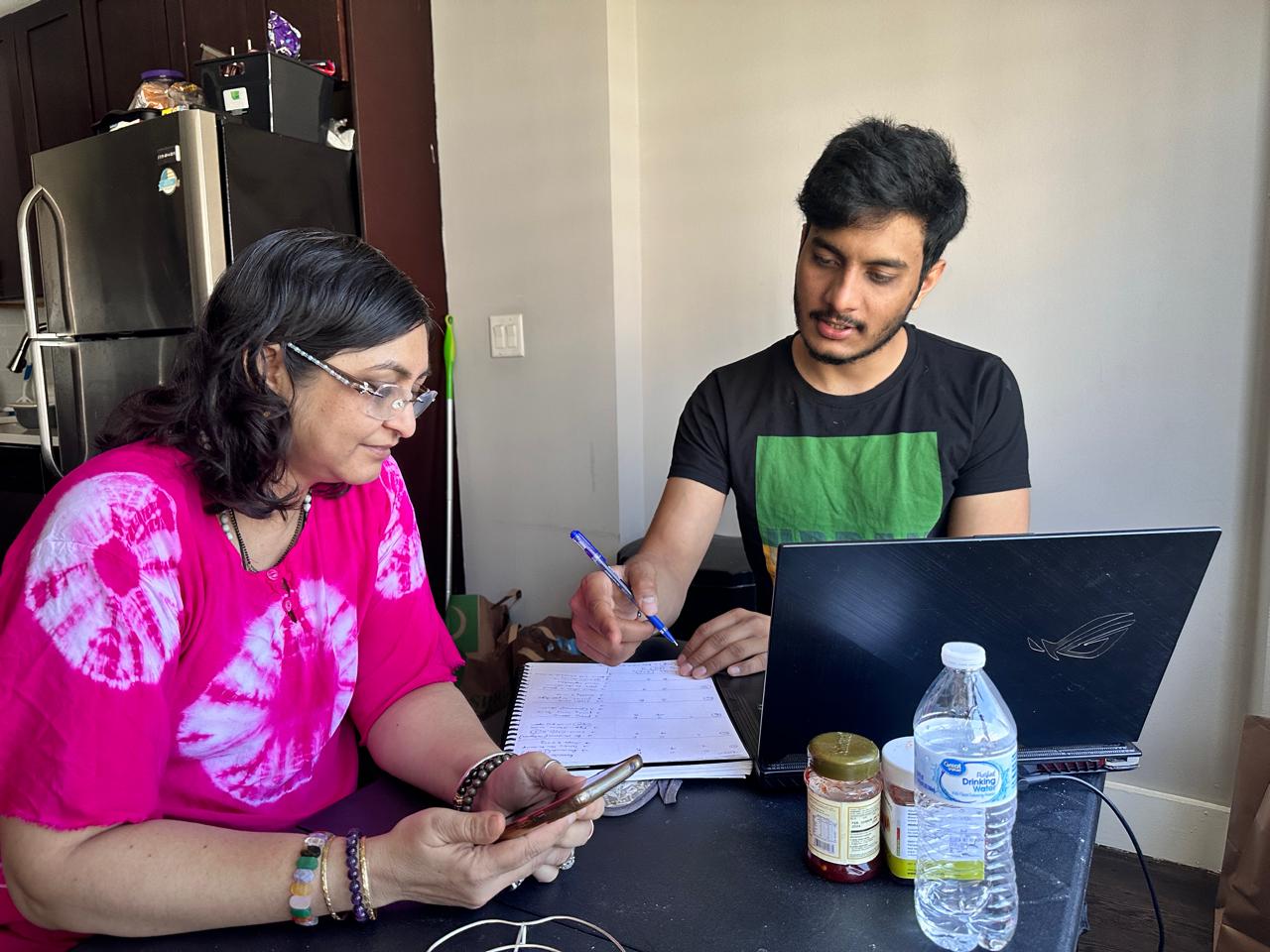
Key Learnings
What Coinquest Taught Me
Through this journey, one thing became clear: control and autonomy are not opposites, they can exist in harmony. Parents don’t need to feel like enforcers, and children don’t need to feel restricted. Instead, the solution lies in empowering both sides.
Control and Autonomy can coexist
I learned that balancing parental control with children's autonomy is essential for effective screen time management solutions.
Simple, engaging design drives behavior change
An intuitive, engaging design motivates responsible screen time habits while offering easy parental controls.
Positive reinforcement works
Gamified features like leaderboards and rewards encourage better habits and foster stronger parent-child bonds.
Go to…
Remodel AI
Led the redesign of a B2B platform, with a dedicated design system to streamline onboarding with 95% success rate.
View Casestudy
B2B
Fintech
CRM
E commerce
Logistics
SaaS
Marketplace

